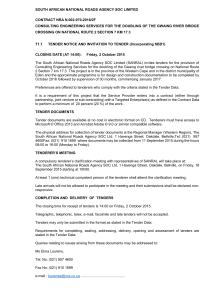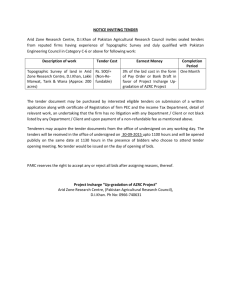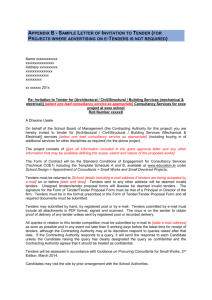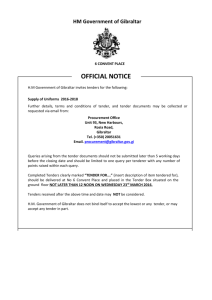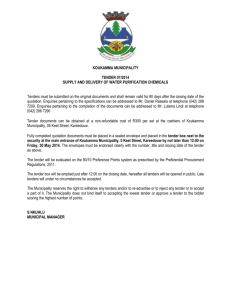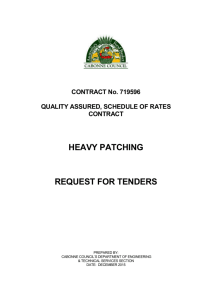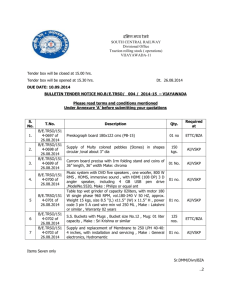4.3 Call for Tender Business Process
advertisement
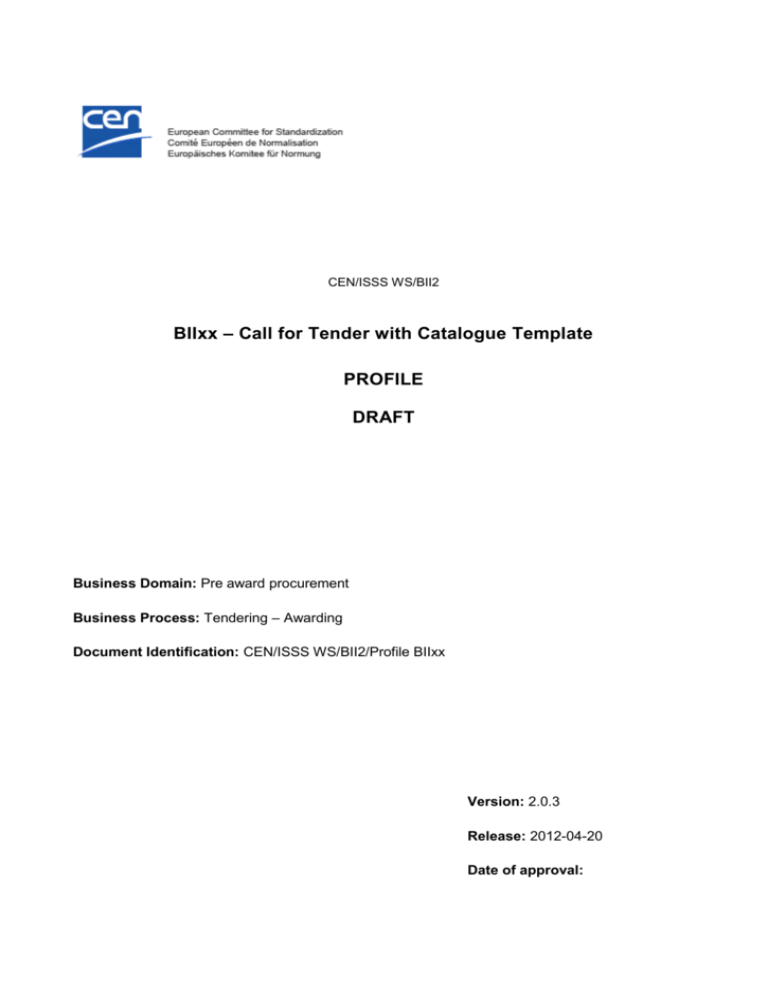
CEN/ISSS WS/BII2 BIIxx – Call for Tender with Catalogue Template PROFILE DRAFT Business Domain: Pre award procurement Business Process: Tendering – Awarding Document Identification: CEN/ISSS WS/BII2/Profile BIIxx Version: 2.0.3 Release: 2012-04-20 Date of approval: CEN WS/BII2/BII22 Call for Tender Page: 2 (24) Document Summary The Call for Tender profile describes a process providing electronic messaging support for the business process of inviting economic operators in a pre-awarding phase. The key aspects covered by this profile are: - The Contracting authority has decided to invite an Economic operator to participate in a pre awarding procedure, sending the Call for Tender document, possibly with the invitation to tender information included. - The Economic operator decides whether he participates in the tendering process, but no communication has to be sent back to the Contracting authority. The profile additionally allows the Contracting authority to send a formal invitation to tender document in an unstructured form to the Economic operator. Editors - Oriol Bausà Peris - Georg Birgisson - Fred van Blommestein - Arofan Gregory - Anders Kingstedt Contributors CEN/ISSS WS/BII2 e-Tendering Working group: - Kornelis Drijfhout (chair), eTendering Team Lead/TenderNed, NL - Ansgar Mondorf, University of Koblenz, DE - Bas Crompvoets, TenderNed, NL - Birgitta Nelson, SFTI/Kammarkollegiet, SE - Chris Mora-Jensen, Inno:vasion, DK - Daniel Reiser, University of Koblenz , DE - Daniel Schmidt, University of Koblenz , DE - Didier Hardy, OJEU, LU - Eduardo Sanchez, Direccion General del Patrimonio del Estado, ES - Frank-Dieter Dorloff, University of Duisburg-Essen, DE - Giampaolo Sellitto, AVCP, IT - Jostein Frømyr, Vice Chair Technical Coordination , NO - Kerstin Wiss-Holmdahl, SFTI/SALAR, SE - Magnus Matts, SFTI/Kammarkollegiet, SE - Manuel Canno, Nexus-it, ES - Marie Bodenhoff, Danish Regions, DK - Nils Fjelkegård, eTendering Team Lead/Kammarkollegiet, SE - Peter Dam Bové, SKI, DK - Piero Milani, InfoCamere, IT - Richard Baker, Sequence, UK - Veit Jahns, University of Duisberg-Essen, DE - Virpi Nieminen, PWC, BE CEN WS/BII2/BII22 Call for Tender Page: 3 (24) TABLE OF CONTENTS 1 Introduction ................................................................................................................................ 4 1.1 1.2 1.3 CEN WS/BII2 profiles .............................................................................................................................. 4 CEN WS/BII2 Pre award support ............................................................................................................ 4 Implementation, conformance and customization ................................................................................... 5 2 Business environment ................................................................................................................ 6 2.1 2.2 2.3 2.4 Introduction .............................................................................................................................................. 6 Objectives ................................................................................................................................................ 6 Scope ...................................................................................................................................................... 6 Tendering procedures ............................................................................................................................. 7 3 Requirements ............................................................................................................................. 8 3.1 Process requirements ............................................................................................................................. 8 3.2 Information requirements ........................................................................................................................ 8 3.2.1 Call for Tender transaction business requirements ........................................................................... 8 3.2.2 Pre-award Catalogue Template transaction business requirements ............................................... 11 4 Profile detailed description ....................................................................................................... 13 4.1 4.2 4.3 4.5 4.5.1 4.5.2 Business processes in scope ................................................................................................................ 13 Roles involved ....................................................................................................................................... 14 Call for Tender Business Process ......................................................................................................... 15 Transaction Information requirements................................................................................................... 16 Call for Tender Transaction .............................................................................................................. 16 Pre-award Catalogue Template Transaction ................................................................................... 20 5 Implementation ......................................................................................................................... 23 6 References ............................................................................................................................... 24 6.1 6.2 General references relevant for all BII profiles ...................................................................................... 24 References specific to this profile .......................................................................................................... 24 CEN WS/BII2/BII22 Call for Tender 1 Page: 4 (24) Introduction This profile is a deliverable of the CEN ISSS BII2 workshop. The original CEN Workshop on Business Interoperability Interfaces for public procurement in Europe (CEN ISSS BII) was concluded in December 2009, and its results, including a set of profiles, were issued as CWA 16073:2010. The objective of the second phase of the workshop – CEN WS/BII2 – was to provide a framework for interoperability in pan-European electronic procurement transactions, expressed as a set of requirements and technical specifications. The requirements are input into UN/CEFACT and the specifications are compatible with UN/CEFACT in order to ensure global interoperability. Based on user input the CEN WS/BII2 has reviewed and updated a number of the profiles published as part of CWA 16073:2010. One of the updated profiles is profile BII22 that describes the Call for Tender process. This version 2 of BII22 – Call for tender is an updated version of the original BII22 profile. The update is not strictly upward compatible. See document xxx for definition of upward compatibility in BII workshop documents. See document xxx for a list of changes. 1.1 CEN WS/BII2 profiles A CEN WS/BII2 profile description is a technical specification describing - the choreography of the business process covered, i.e. a detailed description of the way the business partners collaborate to play their respective roles and share responsibilities to achieve mutually agreed goals with the support of their respective information systems, - the electronic business transactions exchanged as part of the business process, with their information requirements, and the sequence in which these transactions are exchanged, - the business rules governing the execution of that business process, as well as any constraints on information elements used in the transaction data models The profiles focus on the standardization on the organisational and semantics interoperability levels rather than on syntax or technical interoperability levels. Consequently the business transactions within a profile can be structured based on different message standards/syntax as long it can carry all the necessary information elements. Although the profile descriptions and transaction data models provided by CEN WS/BII2 are neutral of syntax, the workshop also published specifications of how its data models may be mapped to defined syntaxes. This is done in order provide implementable specifications. The main focus of the profile description and the associated transaction data models is to address generally expressed business requirements, applicable throughout the European market. Although the profile description is designed to meet generally expressed requirements, it is still the responsibility of the users to ensure that the actual business transactions exchanges meets all the legal, fiscal and commercial requirements relevant to their business. 1.2 CEN WS/BII2 Pre award support The BII workshop has developed a set of profiles to support interoperability in the pre and post award areas. The scope of BII2 is public procurement but the profiles apply as well to private trade since many private customers use tendering as good business practice. In those cases official Notification of calls and contracts is often not applicable. The scope of BII2 pre award profiles include processes that support communication of qualifications, calls for tender with and without catalogue templates, tenders with and without catalogues and contract notices. During these processes additional information need to be exchanged between awarding authorities and economic operators, such as questions and answers and documents supporting a final guarantee. These sub processes are currently out of scope for the workshop. CEN WS/BII2/BII22 Call for Tender Page: 5 (24) The set of BII profiles for supporting the pre award area are: Profile BII11 BII12 BII22 BII36 BIIxx BIIxx 1.3 Qualification Tendering Simple Call for Tender Pre-award Publication Call for Tender with Catalogue Template Tendering Simple with Catalogue Process eTendering eTendering eTendering eNotification eTendering eTendering Version BII2 BII2 BII2 BII2 BII2 BII2 Implementation, conformance and customization CEN WS/BII2 profiles define the core functionality that is required in order to achieve interoperability for the business processes that are covered. Parties, claiming conformance to a CEN WS/BII2 profile must be capable of: - Processing all non-optional transactions that are defined in the profile - Sending all mandatory elements within the transactions - Processing all elements within the transactions they receive Parties may agree bilaterally or within certain communities to extend the core set of information elements, or to adapt their cardinality. This extension mechanism is described in BII2-xxx. In order to implement the profile, the transactions are to be represented in some syntax. Syntax representation is outside the scope of this profile, however, the mapping of the profile transactions to UBL 2.0 and to UN/CEFACT is described in section 5 of this profile, where reference is made to technical documents such as XML schemas, Schematron files and example messages to support technical implementation. Implementations of this profile may be validated by means of tools and supporting material, as described in BII2-xxx. More background information and support material can be found on the CEN WS/BII2 website http://www.cenbii.eu/. CEN WS/BII2/BII22 Call for Tender 2 Business environment 2.1 Introduction Page: 6 (24) Individual pre awarding processes can be followed using different procedures. In open procedures, Economic Operators request access to contract documents (including the call for tender). Restricted, negotiated and competitive dialogue procedures require Contracting Authorities to invite the candidates to the tendering process and to send them the contract documents (including the call for tender). Negotiated procedures require sending the invitation to tender to the selected candidates. 2.2 Objectives The main business benefits to be gained by implementing this profile are: 1. The profile is a basis for an EDI agreement between the parties and enables trading partners to communicate without a previous bi-lateral setup or agreements. 2. The electronic Call for Tender allows the Contracting Authority to install a systematic invitation process. 3. Tenderers can automatically generate tenders issuing tendering documents. 4. Receipt of tendering information allows for an automated tendering process. 2.3 Scope This profile supports the dispatch of the call for tender to facilitate Economic Operators to submit a tender electronically. It is intended to support transmission of electronic documents for processing in semiautomated processes by the receiver. The legal requirements that were taken into account are requirements from European legislation, in particular the EU directives, mentioned in section 6 of this profile. The intended scope for this profile includes Business to Business (B2B) and Business to Government (B2G) relations, with a focus on B2G. The transactions, specified in this profile are intended to be exchanged between the tendering systems of economic operators and contracting authorities. This means that it is expected that the parties have connected their systems to the internet, and that they have middleware in place to enable them to send and receive the transactions in a secure way, using an agreed syntax. The content model of the transactions can also be used in procurement platforms or portals, so that these platforms as well as procurement systems of Economic Operators and Contracting Authority are based on the same information and process models, which makes them more interoperable. Even if platforms are not technically interoperable, the content model facilitates understanding the tendering documents and to participate in the tendering process. CEN WS/BII2/BII22 Call for Tender 2.4 Page: 7 (24) Tendering procedures Article 28 to 34 from Directive 2004/18/EC and article 40 from Directive 2004/17/EC describe the different tendering procedures used by Contracting Authorities. By focusing on the exchange of information steps three abstract process models remain: Open procedure, Restricted procedure and Award of a contract without a prior publication of a contract notice. The Open procedure This procedure starts with the publication of a Contract notice. Economic operators have access to the notice and the contract documents. The contract authority provides the Call-For-Tender to all interested economic operators. After preparing the tenders, all economic operators submit their qualification and tender documents. The contracting authority evaluates all tenders and awards the contract to the winning economic operator. The procedure ends by the publication of the Award of a contract. The Restricted procedure This procedure starts with the publication of a Contract notice. Economic operators have access to the notice and the contract documents. The contract authority provides the Call-For-Tender to all interested economic operators. Based on the Call-For-Tender all economic operators submit their qualification documents first. The contracting authority evaluates the economic operators and invites only the selected ones to submit their tender. After preparing the tenders, the invited economic operators submit their tender documents. The contracting authority evaluates all tenders and awards the contract to the winning economic operator. The procedure ends by the publication of the Award of a contract. This process covers the procedures Competitive dialog and Negotiated procedure with a call for competition as well. The actual dialog or negotiation will most likely not be standardized and is therefore not in scope of this model. Award of a contract without a prior publication of a contract notice This procedure starts with the invitation to selected economic operators to submit their tenders. The contract authority provides the Call-For-Tender to these economic operators. After preparing the tenders, the invited economic operators submit their qualification and tender documents. The contracting authority evaluates all tenders and awards the contract to the winning economic operator. To provide maximum transparency the contracting authority may publish the Voluntary ex ante transparency notice two weeks before the actual Award of a contract. This process covers the Negotiated procedure without a call for competition as well. The actual negotiation will most likely not be standardized and is therefore not in scope of this model. e-Notification Official notification through publishing bodies is part of all procedures. The process of eNotification is described in a separate BII profile document: BII10: Tender Notification. CEN WS/BII2/BII22 Call for Tender 3 Requirements 3.1 Process requirements Page: 8 (24) The Contracting authority decides to invite a reduced number of candidates based on a previous selection (either based on a pre-qualification business process or on a pre-selection list based on other criteria). In open procedures Economic Operators can request access to all contract documents. The Contracting Authority prepares the Call for Tender as a structured document, a template for a pre-award catalogue and optionally an unstructured Invitation to Tender and sends it to the pre-selected Economic operators or to those who requested access. The Economic operator receives and evaluates the Call for Tender, including the pre-award catalogue template, and decides whether to participate or not in the tendering process. 3.2 Information requirements 3.2.1 Call for Tender transaction business requirements ID tbr40-001 tbr40-002 tbr40-003 tbr40-004 tbr40-005 tbr40-006 tbr40-007 tbr40-008 tbr40-009 tbr40-010 tbr40-011 Requirement The call for tenders MUST contain the administrative identification of the contract award process. A unique ID is needed to establish the relation between all the documents in the process, and the awarding procedure by all the actors involved. The information about the contracting party MUST be included in the call for tenders document. The information on the contracting authority is needed to identify the buyer. The call for tenders MAY include information about the beneficiary, if different from the contracting authority. In some cases, such as central purchasing bodies the goods or services will not be used by the contracting authority, but by a different administrative unit. The call for tenders MUST contain a description of the object of the contract. The description of the object of the contract is basic information for both tenderer and contracting authority. The call for tenders MUST contain information about the type of contract (goods, works, services) and corresponding subtype. Type of contracts are defined in article 1 of the Directive 2004/18/EC. Depending on the contract type different articles, thresholds, information, etc. are required. The call for tenders MUST contain information about the classification of the object of the contract (CPV code). CPV is defined in article 1 of the Directive 2004/18/EC. This code is a basic information element for common understanding of the object of the contract in crossborder procurement. The call for tenders MAY contain a list of the required deliverables, expected quantities, features and properties and unitary prices.. Information about deliverables in the call for tenders is useful to specify the details of the goods to be purchased, and can be useful for the tenderer to elaborate the tender. The tender should contain the details about offered deliverables according to the requirements in the call for tenders. The call for tenders MUST contain information about the place where de the works, services or goods will be delivered. The location is basic information for the tenderer to elaborate the tender. The call for tenders MUST contain information about the period of execution of the contract, or date of delivery. The execution period is basic information for the tenderer to elaborate the tender. The call for tenders MAY include information about options to be executed by the contracting authority and possible renewals of the contract. Article 9 of the Directive 2004/18/EC establishes the obligation to include options and renewals in the calculation of the estimated value of the contracts. Option: The contracting authority may establish the option to . The call for tenders MUST contain information about the budget amounts (maximum price of the contract to be awarded). The tenderer cannot make an offer higher than the budget amount, as the administration is not allowed to spend more than the authorised amounts in CEN WS/BII2/BII22 Call for Tender ID Page: 9 (24) Requirement the budget. tbr40-012 tbr40-013 tbr40-014 tbr40-015 tbr40-016 tbr40-017 tbr40-018 tbr40-019 tbr40-020 tbr40-021 tbr40-022 tbr40-023 tbr40-024 tbr40-025 tbr40-026 tbr40-027 The call for tenders MAY contain information about the budget accounts to which the contract will be charged, or the budget distribution in years. Information about the budget account may be useful for the integration with accountability systems. The call for tenders MUST include information about the estimated total value, calculated according with Directive 2004/18/EC. Article 9 of the Directive 2004/18/EC establishes the method for calculating the estimated value of the public contracts. This value is needed for thresholds evaluation. The call for tenders MAY contain ranges related with the acceptable unitary prices for the deliverables requested. The contracting authority may require the tenderer to include unitary prices in the tender which will be applied when ordering for goods or services. The call for tenders MAY contain information about the object of the lots, specific tenderer selection criteria for each lot, different awarding criteria, and execution deadline. Article 9 of the Directive mentions the possibility to divide the contract in lots. Different lots may be awarded to different tenderers in the same award procedure. The call for tenders MUST contain structured information about the exclusion criteria for tenderers who are allowed to participate in the tender process, which may be used for automatic evaluation of the administrative qualification documents submitted by the tenderers, such as personal situation of the tenderer, absence of conviction. . These exclusion criteria regard the requirements mentioned in article 45 of the Directive 2004/18/EC. The call for tenders MAY contain structured information about the selection criteria for tenderers who are allowed to participate in the tender process, which may be used for automatic evaluation of the administrative qualification documents submitted by the tenderers. These selection criteria may concern about technical and financial capabilities, economic operator classification, completed tasks. Ref. articles 46 to 52 of the Directive 2004/18/EC. The contracting authority MAY provide templates for the economic operators to fill out with the requested information for the evaluation of participation requirements. It is common practice for contracting authorities to provide tenderers with templates in order to facilitate the elaboration of tenders. The call for tenders MAY indicate if the evidence for a certain selection or exclusion criteria should be submitted by all the tenderers or only by the winning tenderer after the award of the contract. Best practices recommend contracting authorities to request for evidences only to the winning tenderer in order to reduce administrative burdens. The call for tenders MAY indicate the legal forms of the tenderer (consortium, subcontractor, contractor) which are subject to fulfil certain exclusion and selection criteria. This information is not needed in an structured way, but just as a textual description. Requirement form PEPPOL project. To fill in by PEPPOL. The contracting authority MAY include additional information about the conditions to tender. For example, possible combinations of tenders to lot, or conditional bidding for lots. Annex VII A of the Directive 2004/18/EC. Information to include in the contract notice. The contracting authority MAY include suggested evidences which would be accepted to prove a specific selection or exclusion criterion. Article 51 of the Directive 2004/18/EC. The contracting authority MAY classify the suggested evidences in a certain type of evidences (certification, certified translation, copy, etc.). Code list of evidence types in the PEPPOL project for the VCD. The call for tenders MAY contain structured information about the guarantees required to the tenderers to participate in the tender process. Annex VII A. Information that must be included in the Contract Notices. The call for tenders MAY contain information about allowed subcontract terms if there exists any restriction. Article 60 of the Directive 2004/18/EC. The call for tenders MAY include references to specific legislation applying to the contract. Article 27 of the Directive 2004/18/EC. The call for tenders MAY include information about contacts to obtain additional information. Article 39 of the Directive 2004/18/EC. CEN WS/BII2/BII22 Call for Tender ID tbr40-028 tbr40-029 tbr40-030 tbr40-031 tbr40-032 tbr40-033 tbr40-034 tbr40-035 tbr40-036 tbr40-037 tbr40-038 tbr40-039 tbr40-040 tbr40-041 tbr40-042 tbr40-043 tbr40-044 tbr40-045 tbr40-046 tbr40-047 tbr40-048 Page: 10 (24) Requirement The call for tenders MAY include information about contacts to obtain additional documents. Article 39 of the Directive 2004/18/EC. The call for tenders MUST include information about the address/endpoint for the submission of tenders. Article 40 of the Directive 2004/18/EC. The call for tenders MUST contain information about the procedure for appeal, such us appeal submission period, competent authority, indications for appeals submission. Information required in Annex VII A of the Directive 2004/18/EC. The call for tenders MAY contain structured information about the awarding criteria which could be used for the automatic evaluation of tenders, if tenders were elaborated in a structured way according to this information.. Article 53 of the Directive 2004/18/EC. The call for tenders MAY contain structured information which facilitates the elaboration of structured electronic tenders. It may include the content of the different electronic envelopes to be submitted. Article 40 of the Directive 2004/18/EC. The call for tenders MAY include information about the accepted language of the tenders, if different from the contracting authority official language. Information required in Annex VII A of the Directive 2004/18/EC. The call for tenders MAY indicate if variants are accepted. Article 24 of the Directive 2004/18/EC. The call for tenders MAY indicate the maximum number of variants accepted, if there were a limit. Article 24 of the Directive 2004/18/EC. The call for tenders MAY include a description of the elements of the tender which could be modified in the variants. Article 24 of the Directive 2004/18/EC. The call for tenders MUST include information about of the type of awarding procedure (open/restricted/negotiated/competitive dialogue). Chapter V of the Directive 2004/18/EC regulates the different kinds of procedures. The call for tenders MAY include information about the urgency of the procedure (ordinary/urgent). When urgency is justified deadline periods can be reduced according to Article 38.8 of the Directive 2004/18/EC. The call for tenders MUST include information about the deadline for the submission of tenders. Article 38 of the Directive 2004/18/EC. The call for tenders MAY include information about the deadline for the submission of invitations to tender (restricted/negotiated/competitive dialogue). Article 40 of the Directive 2004/18/EC. The call for tenders MAY include information about the deadline for the request of participation (restricted/negotiated/competitive dialogue). Article 38 of the Directive 2004/18/EC. The call for tenders MUST include information about the public opening of tenders. Information required in Annex VII A of the Directive 2004/18/EC. The call for tenders MAY include the details about electronic auctions, if this mechanism is used to award the contract. Article 54 of the Directive 2004/18/EC. The call for tenders MAY include information about the notices published in different publication media (official journals, newspapers, web pages, etc.) such as prior information notices, contract notices.. This information can be used for supervisor authorities to verify that obligations about notices publication and submission periods have been fulfilled by the contracting authority. The call for tenders MAY attach any additional document or external reference. It may be needed to attach additional documents such as images, graphics, software, maps, plans, etc.. The call for tenders MAY include a justification of the process when needed. For example, it may include the reasons why no contract notice has been published.. Information required in Annex VII A of the Directive 2004/18/EC. The call for tenders MAY include the terms of a framework agreement if the aim of the awarding process is the establishment of a framework agreement. Article 32 of the Directive 2004/18/EC. The call for tenders MAY indicate that the aim of the awarding process is the establishment of a framework agreement, or a dynamic purchasing system. It MAY also indicate that the new contract will be based on an already establish framework agreement or dynamic purchasing system. Directive 2004/18/EC. Framework agreements are defined in article 32. CEN WS/BII2/BII22 Call for Tender ID Page: 11 (24) Requirement Dynamic purchasing systems are defined in article 33. . tbr40-049 tbr40-050 tbr40-051 tbr40-052 3.2.2 ID tbr68-001 tbr68-004 tbr68-005 tbr68-041 tbr68-040 tbr68-006 tbr68-007 tbr68-039 tbr68-011 The call for tenders MAY include a reference to the framework agreement or dynamic purchasing system it is based on. Directive 2004/18/EC. Framework agreements are defined in article 32. Dynamic purchasing systems are defined in article 33. Contracts based on framework agreements may be awarded reopening competition. Contracts based on dynamic purchasing systems must be awarded based on a restricted procedure. The call for tenders MAY include information about funding programs, such as European Commission funding . Information required in Annex VII A of the Directive 2004/18/EC. The contracting authority MAY specify the minimum time frame during which the tenderer must maintain the tender (open procedure). Information required in Annex VII A of the Directive 2004/18/EC. The contracting authority MUST specify if the contract will be awarded based on lowest price or economically most advantageous tender. If the contract will be awarded based on lowest price there is no need to include the awarding criteria block of information. Article 53.1 of the Directive 2004/18/EC. Pre-award Catalogue Template transaction business requirements Requirement A pre-award catalogue template (PCT) must be uniquely identifiable. Ensure that the PCT can be referenced. A reference to the corresponding call for tender by its identifying property document this PCT is a part of must be always specified. Supporting a tendering process by a formal and machine-process able specification of the tendered products and services. An item in a PCT must be uniquely identifiable by an single language-independent token. Ensure that the item can be referenced, e.g., by an id. It must be possible to use standard item identification codes. Use of standardized identification codes, e.g., GTIN. The CPV code for an item must always be specified. In pre-award the CPV nomenclature is mandatory for EU countries. For some countries it is mandatory only in the notification process but in many other countries it may be also be also relevant as a call for tender document. It must be possible to refer an item to the corresponding classes from one or more classification systems. Although, the CPV is mandatory there are many other classifcation systems, e.g., UNSPSC, eCl@ss, or GS1 GPC, that are, on the one side, widly used in practice, in particular in the industry, and on the other side have more features than CPV to describe products and services. By this requirement, it should possible to use this classification systems additional to CPV. It must be possible to specify the relationships (semantic and cardinalities) between different items in the PCT. In particular, in must be possible to specify part-of relationships. To specify that not only an item is tendered, but also additional items belonging to the first one. E.g., items that are accessories for another items or are replacements for defect components of an item. This helps to specified that not only printers are tendered, but also print cartridges. A item property has to be uniquely identifiable. Ensure that the item property can be referenced. It must be possible to refer a item property to any property from a product/service classification system as well as product groups that are specific . Using standardized and predefined properties from accepted standards. Such predefined help to improve the description of an offered item. E.g., a ballpoint pen in eCl@ss: http://www.eclasscontent.com/index.php?id=24240501&version=7_0&language=en&actio CEN WS/BII2/BII22 Call for Tender ID tbr68-011 Page: 12 (24) Requirement n=det Here, several properties (net weight, line thickness, etc.) are attached to this class allowing a detailed and structured description of the products of this class in a standardized manner. I.e., according to eCl@ss an ballpoint point can/should be described by those properties attached in eCl@ss to this class. It must be possible to specify a range of allowed values for an item property. In order to allow the supplier to offer only values in the range the CA needs (e.g. for a RAM memory the CA needs values of 1, 2 or 3 GB and no other values, for a maintenance service the action is request within 1 day). The values information allows also a validation check with respect to the following EO’s offers. CEN WS/BII2/BII22 Call for Tender 4 Profile detailed description 4.1 Business processes in scope Page: 13 (24) Procurement is a complex domain with several key processes, some of which are illustrated in the following figure. uc CENBII01 - Scoping Use Case Notify Pre-aw arding Tender Aw ard Sourcing Procurement Ordering Post-aw arding Fulfilment Billing Payment The Call for Tender profile is part of the Tendering process, as highlighted in the above figure. CEN WS/BII2/BII22 Call for Tender 4.2 Page: 14 (24) Roles involved The following business partners participate in this profile, acting in the roles as defined below. Business partner Description Customer The customer is the legal person or organization who is in demand of a product or service. Examples of customer roles: buyer, consignee, debtor, contracting authority. Supplier The supplier is the legal person or organization who provides a product or service. Examples of supplier roles: seller, consignor, creditor, economic operator. Role/actor Description Contracting authority ‘Contracting authorities’ means the State, regional or local authorities, bodies governed by public law, associations formed by one or several of such authorities or one or more such bodies governed by public law. A ‘body governed by public law’ means bodies: (a) established for the specific purpose of meeting needs in the general interest, not having an industrial or commercial character; (b) having legal personality; and (c) financed, for the most part, by the State, regional or local authorities, or other bodies governed by public law; or subject to management supervision by those bodies; or having an administrative, managerial or supervisory board, more than half of whose members are appointed by the State, regional or local authorities, or by other bodies governed by public law. This term has a narrower scope than the term “Customer” and is in BII treated as a customer role. Economic operator The terms ‘contractor’, ‘supplier’ and ‘service provider’ mean any natural or legal person or public entity or group of such persons and/or bodies which offers on the market, respectively, the execution of works and/or a work, products or services. The term ‘economic operator’ shall cover equally the concepts of contractor, supplier and service provider. It is used merely in the interest of simplification. uc Tendering - Partners and Roles Tendering Customer Contracting Authority Economic Operator Supplier CEN WS/BII2/BII22 Call for Tender 4.3 Page: 15 (24) Call for Tender Business Process The following diagram shows the choreography of the business process implemented by the profile. The choreography of business collaborations defines the sequence of interactions when the profile is run within its context. act CfT w . Catalogue Contracting Authority Economic Operator ActivityInitial Transaction BiiTrns040 Dispatch Call for Tender «Document» Call for Tender «Document» Catalogue Template Transaction BiiTrns068 Receive Call for Tender ActivityFinal Description The Contracting authority sends an electronic Call for Tender document containing the information required for the Economic operator to participate in a tendering process, and a template for a pre-award catalogue. The Call for Tender may also be made available on the web-site and/or the procurement platform of the Contracting Authority. The Contracting authority may send a formal invitation to Tender as an attachment to the call for tender document. The Economic operator evaluates the Call for Tender information and decides whether to accept the invitation or to reject it. If the Economic operator accepts the invitation, the business process follows through an external process. If the Economic operator rejects the invitation, no notification needs to be sent back to the Contracting authority. Pre-conditions The Contracting authority has decided to use an applicable tendering process. In a restricted procedure the Contracting Authority has pre-selected a list of candidate Economic operators. In an open procedure Economic Operators have been given access to the contract documents. Post-conditions The Economic operator can proceed to prepare and submit the qualification or tender. Remarks The invitation to tender is for a negotiated procedure where the Economic Operator could not have all the call for tender information. CEN WS/BII2/BII22 Call for Tender 4.5 Transaction Information requirements 4.5.1 Call for Tender Transaction Page: 16 (24) Categories Description and Values Identifier BiiTrns040 Description A structured electronic document sent or made available by the Contracting Authority to an Economic Operator containing details of the Call for Tender. Partner Types Customer Supplier Authorized Roles Contracting authority Economic Operator Legal Implications By sending or making available the message the Contracting authority commits to the terms expressed in the document. National laws and regulations may apply and, in case of above threshold Call for Tenders, EU directives 2004/18/EC and 2004/17/EC Initial Event Prepare and send a Call For Tender Terminal event Receive and process Call For Tender Scope All Tender procedures. Boundary None CEN WS/BII2/BII22 Call for Tender 4.5.1.1 Page: 17 (24) Call for Tender Transaction Information Requirements Model The structure of the Call for Tender message should be aligned with the structure of the responding Tender, in order to assess the Tenders. The Call for Tender structure is as depicted in the following diagram. Overview CEN WS/BII2/BII22 Call for Tender Information Requirement Model [High level UML model , to be added before the public review] Page: 18 (24) 4.5.1.2 InfRqID Call for Tender Transaction Information Requirements Crd Tree and Business term Usage Data Type ReqID InfCID Note source ReqID [To be added before the public review] 4.5.1.3 Call for Tender Transaction Business Rules RuleID rulenote [To be added before the public review] target errorlevel 4.5.2 Pre-award Catalogue Template Transaction Categories Description and Values Identifier BiiTrns068 Description A structured electronic document sent or made available by the Contracting Authority to an Economic Operator containing the template for a pre-award catalogue to be provided in the tender.. Partner Types Customer Supplier Authorized Roles Contracting authority Economic Operator Legal Implications See Call for Tender Transaction Initial Event Prepare and send a Call For Tender Terminal event Receive and process Call For Tender Scope All Tender procedures. Boundary None CEN WS/BII2/BII22 Call for Tender 4.5.2.1 Page: 21 (24) Pre-award Catalogue Template Information Requirements Model The structure of the pre-award Catalogue should be aligned with the structure of the Catalogue Template. The Catalogue Template structure is as depicted in the following diagram. [High level UML model , to be added before the public review] 4.5.2.2 InfRqID Catalogue Template Transaction Information Requirements Crd Tree and Business term Usage Data Type ReqID InfCID Note source ReqID [To be added before the public review] 4.5.2.3 Catalogue Template Transaction Business Rules RuleID rulenote [To be added before the public review] target errorlevel 5 Implementation [Here reference to the XSDs, WSDLs and all other documentation needed to implement this profile.] CEN WS/BII2/BII22 Call for Tender 6 References 6.1 General references relevant for all BII profiles Page: 24 (24) External documents - UN/CEFACT Modelling Methodology (available at http://www.untmg.org/specifications/) - UML (Unified Modelling Language), version 2.0 Related publications from CEN/ISSS WS/BII: - CWA xxxx-1: Profile Overview - CWA xxxx-1, annex A: Glossary of terms - CWA xxxx-1, annex B: Profile Architecture CWA xxxx-1, annex C: Controlled Vocabulary Approach References to BII2 web site 6.2 References specific to this profile External documents - EU directive 2004/18 – procurement - contracts for public works, public supply and public service - EU directive 2004/17 – procurement in the water, energy, transport and postal services sectors - Commission Decision 2008/963/EC – the current list of contracting authorities and entities - Commission Implementing Regulation (EU) No 842/2011 – Standard forms - Regulation (EC) 213/2008 – the lists and tables Common Procurement Vocabulary - Directive 2009/81/EC on defence and sensitive security procurement
